Blaming the cut of a $5.2 billion government subsidy and rising fuel costs, the Guyana Power and Light yesterday announced that it has filed an application to increase tariffs by 26.7% effective from last month and the company’s Board of Directors is already planning its implementation.
GPL, in a statement yesterday, said that on May 15, the company submitted its Final Return Certificate (FRC) to the Public Utilities Commis-sion (PUC) for the increase. “GPL regrets that as a result of funding denied to them, it has no other option but to move in the direction to raise revenue to remain financially viable,” it said. “The new rates have not taken effect but the GPL Board is actively engaged in planning its implementation,” it added.
In light of the cut of the subsidy during the consideration of the budget in April, GPL’s management had signalled that higher tariffs would be a possibility, although Chairman of the company’s board, Winston Brassington, had suggested that the increase would have been around 17%.
APNU and the AFC, during the examination of the budget estimates in April, slashed GPL’s funding of over $10B by $5.2 billion. Govern-ment was injecting $5.8 billion to support the company in meeting its cash flow requirements and had dedicated a further $5.4 billion to support key projects such as the upgrade of its transmission and distribution network, the loss reduction programme, and other activities required in anticipation of the Amaila Falls Hydropower Project.
The opposition’s reason for the cuts to the GPL expenditure is that the planned spending was not properly explained. Last year, the opposition had also cut GPL’s budgeted allocation and the sum remaining this year is close to what GPL would have operated with last year.
But GPL explained yesterday that the allowable increase of 26.7% is calculated in accordance with the 1999 Electricity Sector Reform Act (ESRA) and its License. The FRC tariff filing, it added, computes how much GPL may increase or decrease its tariffs annually, using an internationally acceptable methodology that is based on a rate of return basis. This methodology calculates the tariffs looking at GPL’s income and expenses, assets, debt and equity in the prior year, GPL further said.
GPL said that a Notice of Compliance issued by an independent firm of Accountants and GPL’s 2012 audited accounts that shows GPL losing $7.6 billion in 2012 accompanied the FRC. It also pointed out that GPL last increased tariffs in 2008.
Speaking at a press conference in April, Prime Minister Sam Hinds stated that the alternative to a 17% tariff increase to offset the cuts would have been a share uptake for the company. And had that been the chosen option, the tariff rates would have had to be adjusted to reflect the economic realities of the company to make it attractive to investors.
GPL’s statement said, “The computed increase in tariffs as stated in the 2013 FRC is based on a deficit of $5.2 billion, and a headline tariff or service tariff increase of 26.7%, that is computed to recover the deficit over an 8-month period (May-Dec, 2013).”
The company blamed the tariff increase on the opposition decision to cut the subsidy, despite available funding from loans provided by Venezuela, China and the Inter-American Development Bank. The company said that it will need at least US$90 million within the next five years for investment, “with considerably more needed if GPL is to make substantial reductions in technical and commercial losses.”
GPL also said that a recent Caribbean Electric Utility Services Corporation (CARILEC) report shows GPL residential tariffs to be one of the lowest in the region, with only Trinidad and Tobago, Suriname, and The Bahamas having lower rates.
GPL said that at its last increase, which took effect in early 2008, the average increase was 14%, with residential customers facing 6% and 9% and the government covering a 20% increase.
The company also said that its fuel cost has risen from a weighted average of US$64 per barrel in 2006 to US$108 per barrel in 2012. “In 2006, GPL’s fuel bill was $12.4 billion; in 2012, this had doubled to $24.2 billion,” the company said, noting that fuel alone accounted for 83% of GPL’s tariff revenue.
By delaying implementing full tariff increases, GPL said it has foregone revenue of over $21.7 billion (after taking account of the $5.2 billion to be recovered from the 26.7%).
GPL also said it projects that the Amaila Falls Hydro-electric project, expected to start construction at the end of 2013, will not be ready until 2017, at which time generation costs are expected to be reduced to half of the current version. “The Amaila Falls project is therefore critical to GPL reducing its costs of generation and the impact of fuel costs on increasing tariffs,” the company said. “GPL is expected to shortly highlight its current position and the challenges it faces, particularly given the reduction of access to loan financing for GPL from its shareholder – the Government of Guyana – to invest in critical improvements in its infrastructure,” it added.








